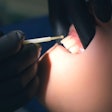
Numerous organizations have made a concerted effort to have parents find a dental home for their children before their first birthday, sometimes even by age 6 months. What is unknown, however, is the effectiveness of early preventive dental care in reducing caries-related treatment and dental expenditures, and whether the type of provider, such as a dentist or primary care provider, matters.
Studying data from Alabama patients enrolled in Medicaid, researchers found that children with early preventive dental care provided by a dentist were more likely to have subsequent dental care than children who did not have such care. However, the patients with a dental home had more caries-related treatment and spent more on treatment than children without such care, according to a study published on February 27 in the journal JAMA Pediatrics.
"Children who received early preventive dental care from dentists were more likely to have caries-related visits and greater caries-related expenditures than children without preventive dental care," wrote the study authors, led by Justin Blackburn, PhD (JAMA Pediatrics, February 27, 2017).
Blackburn is an assistant professor of outcomes research in the department of health organization and policy at the University of Alabama at Birmingham School of Public Health.
Caries-related visits
The caries rate for children younger than age 5, especially in states such as Alabama, is rising, according to the authors. In response, the idea of early preventive dental care being provided by pediatricians or other primary care providers has become accepted.
However, what evidence is there that so-called early-life preventive dental care is effective? Are primary care providers able to deliver this preventive dental care in a way that reduces the caries rate? The researchers wanted to measure the effectiveness of early preventive dental care in reducing caries-related treatment visits among Medicaid-enrolled children from Alabama.
They conducted a retrospective cohort study using data from children continuously enrolled in Medicaid in the state from birth for three or more years from September 2007 through October 2012. Annual caries-related visits and expenditures were measured, along with total dental expenditures for children in their third through sixth year of enrollment or when they were no longer enrolled in Medicaid. The analysis was restricted to those enrollees with at least one paid claim. The top 1% of children in total expenditures were excluded.
Almost 20,000 eligible children were identified, with more than 3,600 receiving early preventive dental care from a dentist. Separately, more than 850 children received preventive dental care from a primary care provider. The largest group of these children were black (44%), followed by children who were white (37.6%) and Hispanic (16.3%).
The main outcome measure reported was annual caries-related visits and expenditures beginning in the child's third year of life. As the table below shows, children with early preventive care had more treatment for caries, more visits per child year, and higher dental expenditures.
| Comparison of kids with and without early preventive dental care | ||
| Outcome | Kids with early preventive care | Kids without early preventive care |
| Caries treatment | 20.6% | 11.3% |
| Rate of visits | 0.29 per child year | 0.15 per child year |
| Dental expenditures | $168 per year | $87 per year |
Among children who received early preventive dental care, the authors reported 2,190 caries-related visits in 2,104 unique children in 9,732 child years of follow-up, for a rate of 22.5 visits per 100 child years. For children who received the preventive dental care from a primary care provider, there were 323 caries-related visits among 321 unique children in more than 2,174 child years of follow-up, for a rate of 14.9 visits per 100 child years.
Preventive dental care delivered by primary care providers did not have a significant impact on the outcome measures, the authors noted. Children who received preventive dental care from primary care providers had similar caries-related visits and expenditures compared with children without preventive dental care, the authors noted. Finally, the frequency of preventive dental care did not modify this effect.
"We observed no evidence of a benefit of early preventive dental care, regardless of the provider," the authors concluded. "In fact, preventive dental care from dentists appears to increase caries-related treatment."
Editorial points to study limitations
The authors noted several limitations to their study, including that claims data cannot capture any indirect benefits of preventive dental care, such as reductions in missed school days or an improved quality of life. They also acknowledged it was not possible to evaluate the clinical need for caries-related visits, the presence of caries and tooth decay, or variations in the quality of care provided. Also missing was information about behaviors related to oral health, such as toothbrushing.
They also noted a lack of precise data on Alabama's water fluoridation and a "noticeable variation over time in Alabama's water fluoridation."
In an editorial accompanying the study, Peter Milgrom, DDS, and Joana Cunha-Cruz, DDS, PhD, wrote that these major limitations made it difficult to draw conclusions from the study, but they noted the study was well-executed.
This may be a case in which a child being seen logically leads to more visits and treatment, the editorial authors wrote.
"The most reasonable conclusion is that children with early tooth decay are identified early and subsequently are more likely to be referred for treatment at an earlier stage," they wrote.
Drs. Milgrom and Cunha-Cruz noted that the only validated measure of tooth decay risk are those early signs of tooth decay itself. They pointed out that children receiving preventive services could have been receiving it as an early-age treatment.
"The study misses the opportunity to assess this important issue by not reporting or adjusting for decay-related treatments before age 2 years," they wrote.
In addition, they noted that anticipatory guidance about fluoridated toothpaste and restrictions on sugary drinks and foods are not recorded in Medicaid claims, and, therefore, the researchers could not take these efforts into consideration.
"Finally, we cannot rule out the possibility that there is a true effect in which preventive visits lead to higher caries-related treatment as a result of ineffective anticipatory guidance and fluoride varnish applications," they wrote. "Fluoride varnish may not be effective if applied infrequently or if the varnish prescribed is ineffective."
Both the authors of the study and the editorial agreed, however, that this is just the beginning and more research is needed.
"Additional research beyond administrative data may be necessary to elucidate any benefits of early preventive dental care," the study authors concluded.
Drs. Milgrom and Cunha-Cruz agreed.
"The work by Blackburn and colleagues is important, because it addresses a huge public health problem, but it is not definitive," they noted. "As far as studies of administrative data are concerned, Medicaid could help by clarifying and redefining covered services."



















